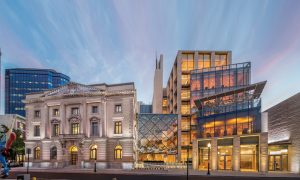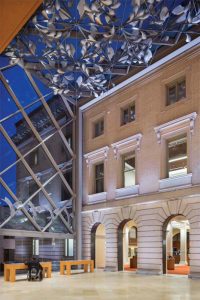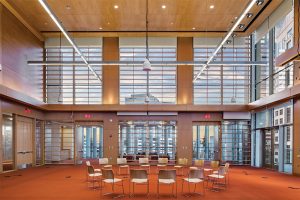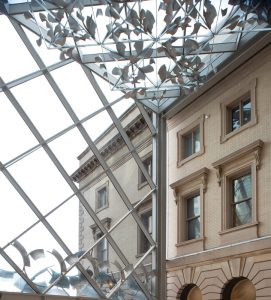Connecting Old and New
In response to growth in the region, the vision for Slover Library in Norfolk, Virginia, was a state-of-the-art public space that would serve the 21st century needs of the community and learners of all ages. The challenge: renovating a 115-year-old historic building, renovating a mid-century commercial building, and connecting the two with a new, modern addition. The result is the 135,000-square-foot Slover Library complex that redefines how a public library is used.
Slover Library is a portal to global information, serving the public through technology built on robust data and infrastructure. This is accomplished through engaging wall-sized touch-panel displays, custom interactive software, computing and media labs, training spaces, video production, and high-tech meeting spaces. It is a world-class “village green” space for community engagement and thoughtful conversations on issues important to the region and beyond. Slover’s Sergeant Memorial Collection is the storehouse for the region’s history, artifacts, and genealogy dating back to the settlement of the new world.
No longer is a library defined as just a repository for books. Instead, it is a community anchor for civic engagement and access to next-generation thinking, innovation, digital content, research, and creativity. What better way to achieve this world-class placemaking vision than to design a beautiful and engaging “past to present” experience for the community – a deliberate, physical connecting of the old and the new.

Tight Urban Site
Since the 1990s, the city of Norfolk has aggressively engaged in rebuilding its downtown with new infrastructure, vibrant mixed-use developments, and a new light rail system. Slover Library was envisioned as the anchor for this new downtown district adjacent to the MacArthur rail station – a vital location to serve its leading-edge purpose in the community. This location, however, presented some challenges. The site chosen for the Slover library is surrounded on three sides by existing structures, two of which, The Seaboard Building and Selden Arcade, would need to connect to the new facility directly.
The historic Seaboard Building is located to the east of the new site. Built in 1900 as a post office and federal courthouse, the city took over the property in 1934 as Norfolk’s City Hall. It remained so until the mid-60s when the City Hall moved to a new facility. The Seaboard Building housed Norfolk’s Social Services until the early 1970s. After that, it was privately-owned until the City of Norfolk re-purchased it in 2007. It was listed on the National Register of Historic Places in 1981. To the west is the Selden Arcade, a 1930s two-story retail and office space used by retailers and financiers into the 1980s, but many storefronts were vacant by 1995. The City of Norfolk purchased the Arcade in 2003 and recently converted it to serve as a studio space for the more than 40 artists of the d’Art Center. To the south is an eight-story city-owned parking garage.
Because of unsuitable soils that extended to an elevation of about 50 feet below the existing grade, it was determined that the new building would need to be supported on deep foundations. Several options were considered, including driven piles and auger cast piles. One of the factors significantly influencing this decision was that the new building would be constructed immediately adjacent to the existing historic structures. With driven piles, there was great concern that the resulting ground vibrations might cause damage to these buildings. So, the decision was made to use 14-inch-diameter auger cast piles. But since they would need to extend to tip elevations of 100 feet below grade, removing the spoils associated with traditional auger cast pile installation would be a considerable cost. The team chose to use drilled soil displacement piles, a type of auger cast pile to mitigate this. Instead of removing the soil material, the soil is displaced laterally into the surrounding soil resulting in a similarly profiled regular shaft pile but with minimal spoils.
These piles had the additional advantage of being able to be installed very close to the existing buildings. This minimized the length that the grade beams needed to cantilever to support the new columns set close to the existing buildings.
Another consideration of tight urban sites is the lack of convenient material laydown areas. This was one of the factors that influenced the decision that the majority of the new structure would consist of cast-in-place concrete over structural steel. The amount of space required to store reinforcing bars is much less than that required for structural steel, and the erection can often be done just as quickly.
High Water Table
In Norfolk, the water table is relatively high; most basements in this area extend below the water table. Not surprisingly, the basement in the 115-year-old Seaboard building had a history of leaking and even flooding during significant rain events. So, the first challenge was to provide a reliable waterproofing system to the existing building. The waterproofing system the team employed for the Seaboard building consisted of a network of pipes that could remove a large amount of water from the soil, combined with a positive water barrier on the outside of the basement walls. Next, within the existing basement, a new waterproof membrane was installed on top of the existing slab on grade and extended up the inside of the basement walls. Finally, a new 4-inch topping slab was installed on top of a 4-inch sand bed to finish the basement floor and protect the waterproof membrane.
The new Slover Library needed to connect to that basement to allow elevator access to the Seaboard. But a slightly different waterproofing system was designed for the new structure. The new system consisted of waterproofing on the outside of the basement walls with an exterior foundation drainage system. Still, inside, there is a structural slab over a vapor barrier designed for the hydrostatic uplift should the water table rise despite the exterior drainage system.

Connecting Old and New
As with many historic preservation projects, the team was faced with several unique challenges throughout this project. The most significant structural challenge was the lack of documentation of the Seaboard building’s structure. Destructive investigation in advance of the design was not possible because the building was in use until just before the construction was scheduled to begin. So, the design team was forced to make many assumptions based on limited field investigation. Existing beams were encased in concrete for fireproofing, as was typical for that era. So, the sizes and depths of beams were estimated. When construction began and crews started to remove some of the finishes, the engineers could verify their assumptions. In addition to determining actual member sizes, it was also necessary to verify the material properties. To do this, engineers obtained samples of the structural steel to confirm that it was consistent with A-36 steel and the concrete to determine the compressive strengths.
Through the verification process, it was discovered that one area, which would be the future home for the library’s precious historic collections, was not able to support this proposed loading. The first thought was that these areas would need to be removed and replaced. But upon further investigation, it was determined that the existing 5½-inch concrete slab could be removed and new beams installed between the existing beams. A lighter slab on steel deck system was designed on this new steel grillage, thus preserving much of the existing structure.
Because the Seaboard Building is listed on the National Historic Register, the team was required to preserve and protect as much of the original building fabric as possible. So, connections to the new structure had to be carefully planned and approved by the Commonwealth’s Department of Historic Resources. The floor plans were designed to connect the buildings above the first floor with a series of pedestrian bridges over an ample open atrium space. These were coordinated with the locations of existing windows in the Seaboard Building so that only a small portion of the wall below the windowsill needed to be removed.

Project Success
Design and construction occurred between 2009 and 2015. Slover is certified LEED Gold. It also won a 2015 AIA/ALA Building Award from the American Institute of Architects and the American Library Association, recognizing excellence in innovative design as leading to the library’s resurgence as a community hub. Slover is also a DBIA (design-build) award winner.

A combined public and private endeavor, the $65 million building was made possible by a $40 million gift from Frank and Jane Batten and a $21 million contribution from the City of Norfolk. In addition, the project led to the creation of the Slover Foundation, which contributed an additional $4 million to the initial construction. The library is named in honor of Colonel Samuel L. Slover, a former Mayor of Norfolk and uncle of Frank Batten, Sr.■
Project Team
Structural Engineer: Lynch Mykins
Architects: Newman Architects
Ornament: Kent Bloomer Studio
Urban Designer: Urban Design Associates
Geotechnical Engineer: Schnabel Engineering
General Contractor: Turner Construction
Lighting Designer: Patrick Quigley Associates
Civil Engineer: Timmons Group
Landscape Architect: Michael Vergason Landscape Architects
